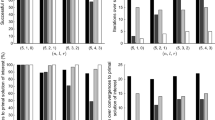Abstract
A convex programming problem in a Hilbert space with an operator equality constraint and a finite number of functional inequality constraints is considered. All constraints involve parameters. The close relation of the instability of this problem and, hence, the instability of the classical Lagrange principle for it to its regularity properties and the subdifferentiability of the value function in the problem is discussed. An iterative nondifferential Lagrange principle with a stopping rule is proved for the indicated problem. The principle is stable with respect to errors in the initial data and covers the normal, regular, and abnormal cases of the problem and the case where the classical Lagrange principle does not hold. The possibility of using the stable sequential Lagrange principle for directly solving unstable optimization problems is discussed. The capabilities of this principle are illustrated by numerically solving the classical ill-posed problem of finding the normal solution of a Fredholm integral equation of the first kind.
Similar content being viewed by others
References
F. P. Vasil’ev, Optimization Methods (MTsNMO, Moscow, 2011) [in Russian].
M. I. Sumin, “Duality-based regularization in a linear convex mathematical programming problem,” Comput. Math. Math. Phys. 47 (4), 579–600 (2007).
M. I. Sumin, Ill-Posed Problems and Solution Methods (Nizhegorod. Gos. Univ., Nizhny Novgorod, 2009) [in Russian].
M. I. Sumin, “Regularized parametric Kuhn–Tucker theorem in a Hilbert space,” Comput. Math. Math. Phys. 51 (9), 1489–1509 (2011).
M. I. Sumin, “On the stable sequential Kuhn–Tucker theorem and its applications,” Appl. Math. 3 (10A) (special issue “Optimization”), 1334–1350 (2012).
M. I. Sumin, “Stable sequential convex programming in a Hilbert space and its application for solving unstable problems,” Comput. Math. Math. Phys. 54 (1), 22–44 (2014).
K. Arrow, L. Hurwicz, and H. Uzawa, Studies in Nonlinear Programming (Stanford Univ. Press, Stanford, 1958; Inostrannaya Literatura, Moscow, 1962).
M. Minoux, Mathematical Programming: Theory and Algorithms (Wiley, New York, 1986; Nauka, Moscow, 1990).
J. Warga, Optimal Control of Differential and Functional Equations (Academic, New York, 1972; Nauka, Moscow, 1977).
M. I. Sumin, "Suboptimal control of distributed-parameter systems: Normality properties and a dual subgradient method," Comput. Math. Math. Phys. 37 (2), 158–174 (1997).
M. I. Sumin, “Suboptimal control of distributed-parameter systems: Minimizing sequences and the value function,” Comput. Math. Math. Phys. 37 (1), 21–39 (1997).
P. D. Loewen, Optimal Control via Nonsmooth Analysis (Am. Math. Soc., Providence, R.I., 1993).
V. M. Alekseev, V. M. Tikhomirov, and S. V. Fomin, Optimal Control (Nauka, Moscow, 1979) [in Russian].
J.-P. Aubin and I. Ekeland, Applied Nonlinear Analysis (Wiley, New York, 1984; Mir, Moscow, 1988).
A. B. Bakushinskii, “Methods for solving monotonic variational inequalities based on the principle of iterative regularization,” USSR Comput. Math. Math. Phys. 17 (6), 12–24 (1977).
A. B. Bakushinskii and A. V. Goncharskii, Iterative Methods for Ill-Posed Problems (Nauka, Moscow, 1989) [in Russian].
M. I. Sumin, “Iterative regularization of the dual subgradient method for solving Fredholm integral equations of the first kind,” Vestn. Nizhegorod. Univ. Ser. Mat., No. 2, 193–209 (2004).
M. L. Krasnov, A. I. Kiselev, and G. I. Makarenko, Integral Equations (Nauka, Moscow, 1976) [in Russian].
Author information
Authors and Affiliations
Corresponding author
Additional information
Original Russian Text © F.A. Kuterin, M.I. Sumin, 2017, published in Zhurnal Vychislitel’noi Matematiki i Matematicheskoi Fiziki, 2017, Vol. 57, No. 1, pp. 55–68.
Rights and permissions
About this article
Cite this article
Kuterin, F.A., Sumin, M.I. Stable iterative Lagrange principle in convex programming as a tool for solving unstable problems. Comput. Math. and Math. Phys. 57, 71–82 (2017). https://doi.org/10.1134/S0965542517010092
Received:
Published:
Issue Date:
DOI: https://doi.org/10.1134/S0965542517010092



